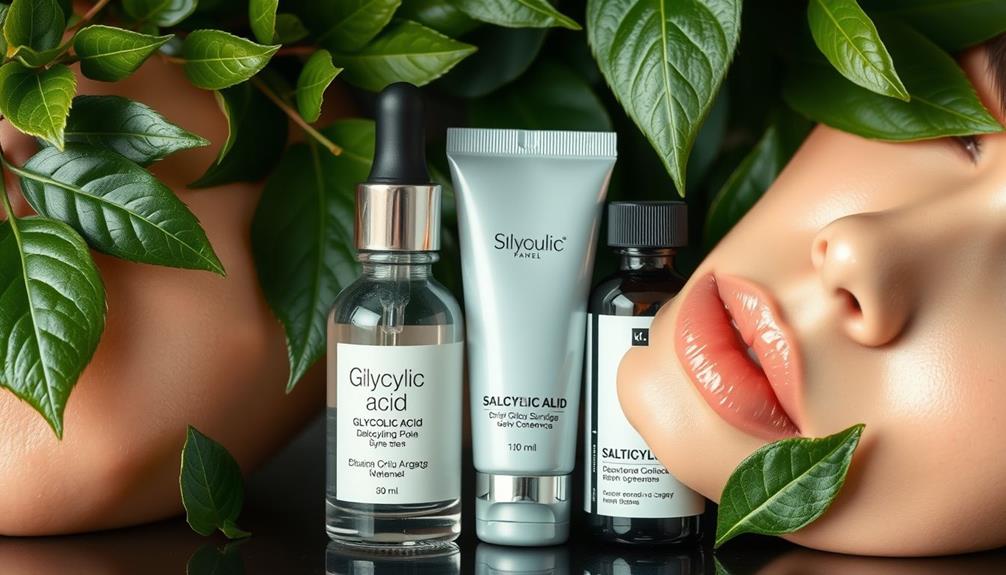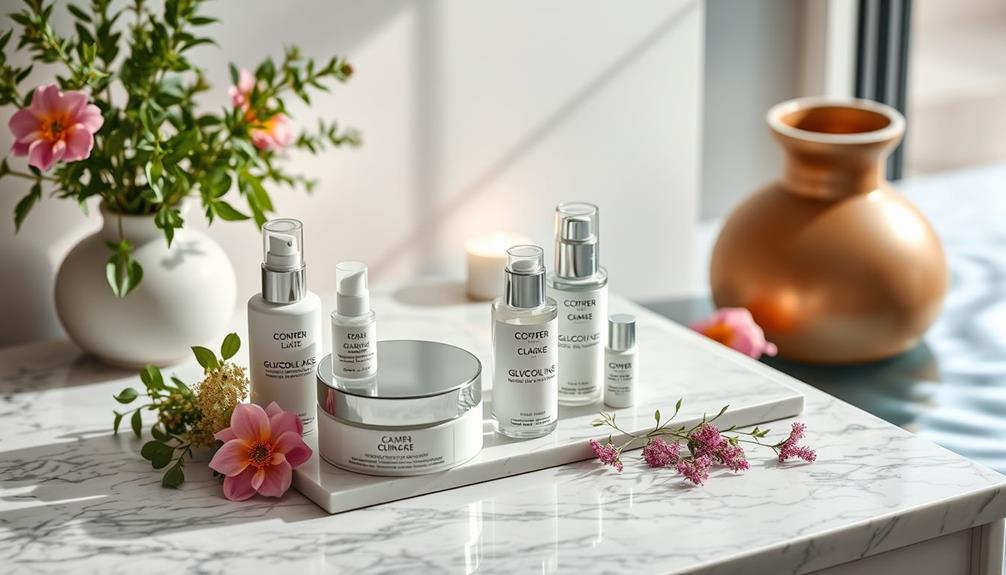Glycolic and salicylic acids are a dynamic duo in skincare, perfect for tackling various concerns like acne and uneven skin texture. Glycolic acid, an AHA, exfoliates and hydrates, while salicylic acid, a BHA, penetrates deep into pores to reduce breakouts and blackheads. Together, they enhance exfoliation, making your skin smoother and clearer. To maximize benefits, start with lower concentrations and alternate usage days to prevent irritation. Always follow up with moisturizer and apply sunscreen daily, as these acids can increase UV sensitivity. Discover how to effectively incorporate this powerful combo into your routine for ideal results.
Key Takeaways
- Glycolic acid exfoliates surface skin, while salicylic acid penetrates pores, effectively addressing both surface and deep skin issues.
- Combining these acids enhances skin clarity, reduces breakouts, and improves overall texture through increased cell turnover.
- Gradual introduction and alternating use of glycolic and salicylic acids minimize irritation while maximizing benefits for various skin types.
- Always follow acid application with a moisturizer and sunscreen to protect the skin barrier and prevent UV sensitivity.
Glycolic Acid Explained
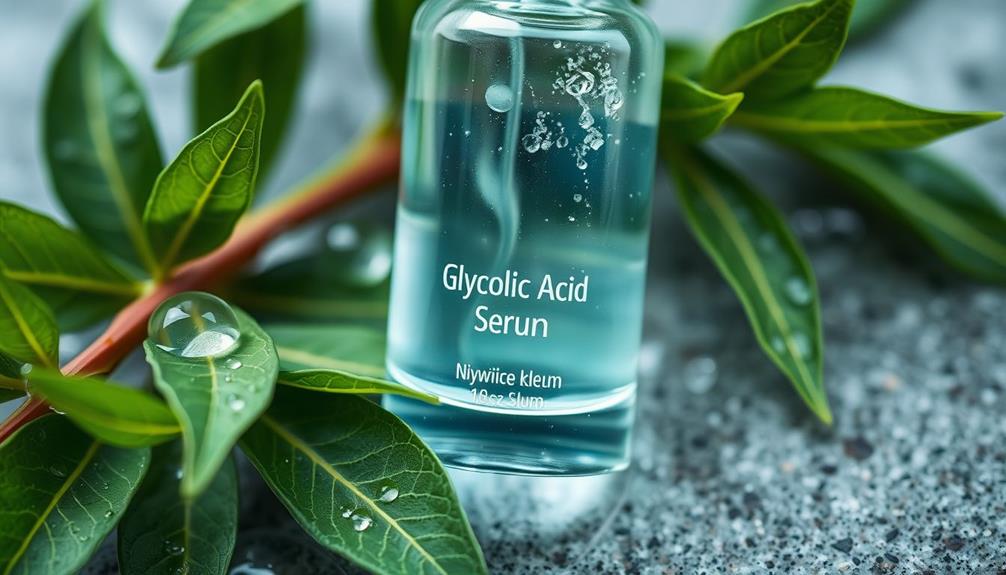
Glycolic acid, a powerful alpha hydroxy acid derived from sugarcane, penetrates deeply into your skin to boost exfoliation and promote cell renewal.
Its small molecular size enhances its exfoliating properties, effectively loosening the bonds between dead skin cells. This process results in a smoother and brighter complexion, making it a favorite in skincare routines.
Additionally, aromatherapy oils like lavender can complement your skincare regimen by promoting relaxation and enhancing overall well-being.
When you use glycolic acid, you can expect significant improvements in issues like uneven skin texture and hyperpigmentation.
Its ability to promote skin cell renewal helps fade dark spots and fine lines, making it a crucial ingredient in many anti-aging treatments.
Additionally, glycolic acid works to retain moisture in your skin, contributing to overall hydration.
However, keep in mind that glycolic acid is best suited for combination to oily skin types.
Its potent exfoliating effects mightn't be suitable for sensitive or atopic skin, so it's necessary to assess your skin's tolerance before incorporating it into your regimen.
Salicylic Acid Benefits
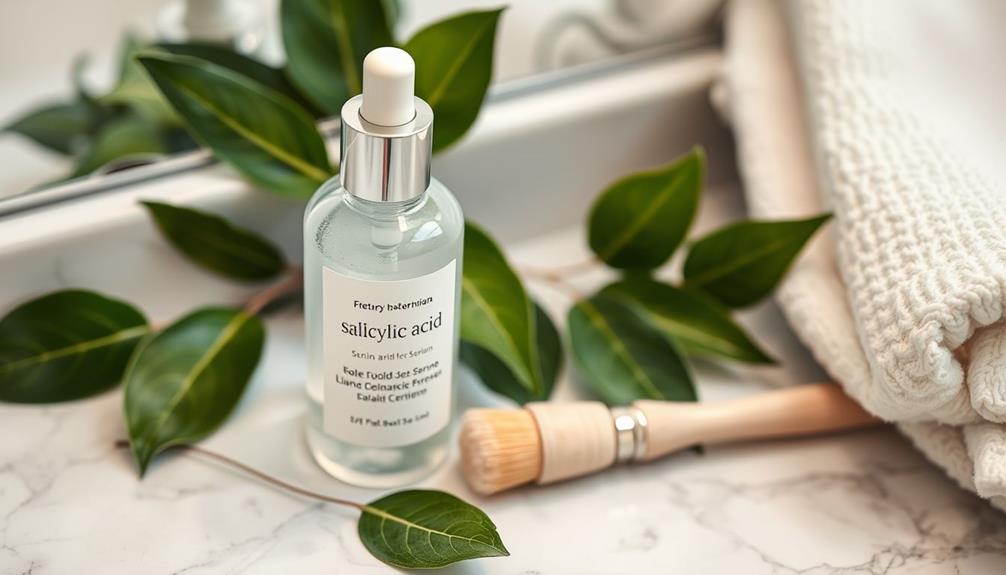
Salicylic acid offers distinct benefits for skincare, especially for those struggling with acne and oily skin. This powerful beta hydroxy acid (BHA) penetrates deep into your pores, effectively dissolving excess oil and unclogging them. Incorporating salicylic acid into your routine can be as beneficial as enjoying fresh orange juice for immunity.
Here's what salicylic acid can do for you:
- Exfoliating: It helps remove dead skin cells, preventing blockages that lead to breakouts.
- Anti-inflammatory properties: Salicylic acid reduces redness and swelling, promoting a clearer complexion.
Using salicylic acid can considerably improve your skin texture, making it smoother and more even. Clinical studies highlight its effectiveness in treating blackheads and whiteheads, showcasing its ability to keep your skin clear and healthy.
If you're dealing with persistent acne or oily skin, incorporating salicylic acid into your routine can be a game-changer. With consistent use, you'll notice fewer breakouts and an overall improved appearance.
Don't underestimate the power of this ingredient; it might just be the solution you've been searching for.
The Synergy of Both Acids
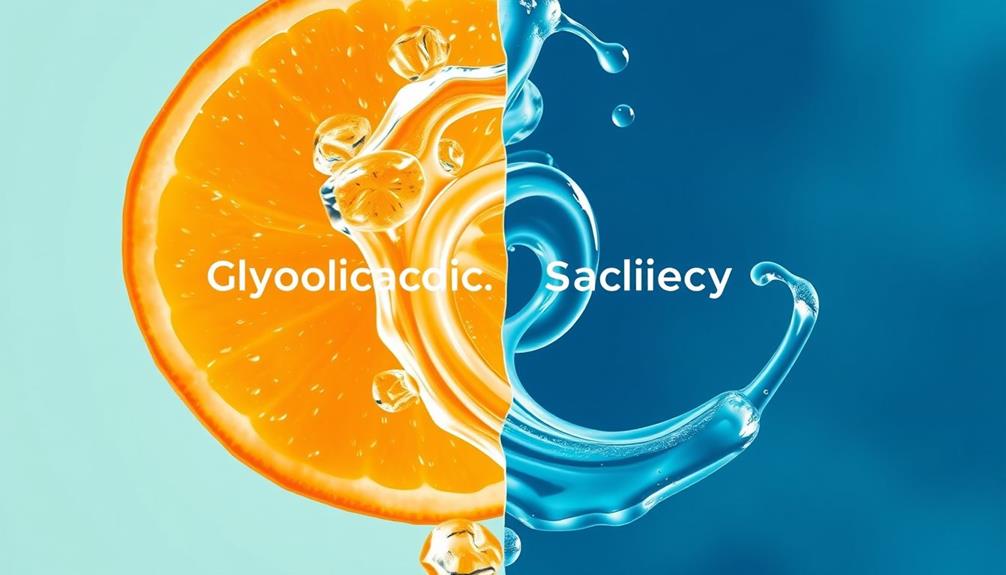
When you use glycolic and salicylic acids together, you reveal enhanced exfoliation benefits that can transform your skin.
This powerful combo not only helps clear up acne but also improves your overall skin texture.
Incorporating a consistent skincare routine, much like how maintaining a consistent sleep schedule can enhance rest, is essential for achieving the best results.
Enhanced Exfoliation Benefits
By combining glycolic and salicylic acids, you can achieve enhanced exfoliation that effectively tackles both surface dead skin cells and deep pore congestion. This powerful duo works synergistically to not just clear your skin but also improve its overall texture.
Here's how they help:
- Glycolic acid loosens the bonds between dead skin cells, allowing for easy removal.
Together, they fade hyperpigmentation and minimize the appearance of enlarged pores.
With this dual-action approach, you'll notice an increase in skin cell turnover, leading to a smoother, clearer complexion. Your skin will feel revitalized as the combination addresses active breakouts while also tackling the root causes of uneven skin texture.
To maximize benefits, it's crucial to introduce these acids gradually into your skincare routine. This way, you'll enjoy the full exfoliation potential without overwhelming your skin.
Both glycolic and salicylic acids offer a transformative experience, making them ideal for anyone looking to improve their skin's appearance effectively.
Targeted Acne Treatment
The powerful combination of glycolic and salicylic acids not only enhances exfoliation but also serves as a targeted treatment for acne, effectively addressing both surface imperfections and deep-seated blemishes.
Glycolic acid, an alpha hydroxy acid (AHA), works to exfoliate the skin's surface, improving texture and promoting skin clarity.
Meanwhile, salicylic acid, a beta hydroxy acid (BHA), dives deep into your pores to dissolve excess sebum and unclog them, tackling the root causes of acne.
Using these acids together creates a dual-action approach that combats active breakouts while preventing future acne formation.
This synergy promotes cellular turnover and reduces inflammation, leading to clearer skin over time.
Studies show that regular use of glycolic and salicylic acids can greatly minimize the appearance of blemishes and post-acne scars.
If you have sensitive skin, it's wise to start with lower concentrations of each acid and monitor your skin's reaction.
This way, you can reap the benefits of targeted acne treatment without causing irritation.
Embrace the power of this combination for a clearer, smoother complexion!
Best Practices for Combining

Combining glycolic and salicylic acids can enhance your skincare routine, but starting with low concentrations is essential to minimize irritation, especially for sensitive skin. Here are some best practices to help you effectively incorporate these acids:
- Alternate Usage: Use glycolic acid one day and salicylic acid the next. This approach prevents over-exfoliation while still providing the benefits of both acids.
- Monitor Reactions: Pay close attention to how your skin reacts. Adjust the frequency or concentration based on your skin's response to avoid excessive skin irritation.
Incorporating both glycolic and salicylic acids can maximize their exfoliating effect, addressing issues like acne and uneven texture. However, make sure to follow up with broad-spectrum sunscreen since these acids can increase UV sensitivity.
If you're unsure about combining these acids or have specific skin concerns, consulting a dermatologist can provide personalized advice. By following these best practices, you'll be on your way to achieving healthier, clearer skin.
Potential Skin Reactions

When using glycolic and salicylic acids, you might notice some common skin irritations like redness or dryness, especially if you have sensitive skin.
It's essential to pay attention to any tingling or stinging sensations, as these can indicate sensitivity.
To minimize potential reactions, patch testing is a smart step before fully incorporating these acids into your routine.
Common Skin Irritations
Using glycolic and salicylic acids can lead to common skin irritations like redness, dryness, and peeling, especially if you have sensitive skin. It's important to be aware of how your skin reacts when introducing these powerful ingredients into your routine.
Here are some potential skin reactions you might encounter:
- Redness: Your skin may appear inflamed or irritated after application, particularly if you're using higher concentrations.
- Dryness: Both acids can strip moisture from your skin, leading to a rough texture and flakiness.
If you experience a burning or stinging sensation, it's a sign you may be overdoing it. Always remember to conduct a patch test before fully committing to these acids.
Adjust your usage frequency based on your skin's tolerance to prevent further irritation. While glycolic and salicylic acids can work wonders, staying mindful of your skin's response is key to achieving the best results without adverse effects.
Sensitivity and Redness
Incorporating glycolic and salicylic acids into your skincare regimen can heighten sensitivity and redness, especially for those with already delicate skin. Both acids can cause irritation, leading to burning, stinging, or peeling. If you have dry or sensitive skin, you might be particularly prone to these adverse reactions.
To minimize the risk of irritation, it's best to start with lower concentrations of each acid. Gradually increasing the strength as your skin builds tolerance can help you avoid overwhelming your skin. Keep an eye on how your skin reacts; if you notice increased redness or sensitivity, consider adjusting the frequency of use.
Always remember that sensitivity varies from person to person. What works for someone else may not suit you, so being attentive to your skin's needs is essential. If you experience persistent irritation, it's wise to consult a dermatologist for personalized advice tailored to your skin type.
Patch Testing Importance
Patch testing is crucial for gauging your skin's sensitivity to glycolic and salicylic acids before diving into regular use. This step helps you avoid potential irritation and adverse reactions that could arise from combining these acids.
Here's what you should do:
- Apply a small amount of the product to a discreet area of skin, typically on your inner arm.
- Monitor the area for 24 to 48 hours for any signs of skin sensitivity.
Individuals with sensitive skin should be particularly cautious, as the risk of irritation, dryness, and peeling increases with these acids. Regular patch testing is critical, especially when introducing new formulations or increasing concentrations, to guarantee ongoing skin compatibility.
Always remember, just because a product works for someone else doesn't mean it'll be suitable for you. Taking this precaution not only protects your skin but also helps you make informed decisions about incorporating glycolic and salicylic acids into your routine.
Prioritize your skin's health and comfort by practicing effective patch testing!
Recommended Products

Explore a range of recommended products that harness the power of glycolic and salicylic acids to transform your skincare routine.
If you're dealing with acne-prone skin, Paula's Choice CLEAR is a great option. It features salicylic acid to effectively reduce breakouts while promoting smoother skin texture.
For a more intensive treatment, try The Ordinary AHA 30% + BHA 2% Peeling Solution. This powerful blend of glycolic and salicylic acids delivers deep exfoliation, improving your skin tone and texture in just 10 minutes.
Neutrogena Oil-Free Acne Wash is another fantastic choice, as it combines salicylic acid for clearing acne and preventing future breakouts, all while being gentle on your skin.
If you want to address sun damage and uneven skin tone, consider Caudalie Vinoperfect Glycolic Peel. This glycolic acid-based treatment promotes a brighter, more even complexion.
Finally, the Derma-TX Glycolic & Salicylic Power Peel is ideal for various skin types, enhancing rejuvenation and tackling enlarged pores and signs of aging.
Incorporate these products into your routine for effective results!
Application Techniques

To maximize the benefits of glycolic and salicylic acids, mastering the application techniques is key. Start by cleansing your face thoroughly and ensuring it's dry. This step is vital for ideal absorption and effectiveness. Use a cotton pad to apply the acid solution evenly across your skin, steering clear of sensitive areas like your eyes and mouth.
Here are some tips to enhance your application routine:
- Allow the product to sit on your skin for 2-3 minutes. This gives the acids time to work their magic.
- Follow up with a moisturizer to lock in hydration and soothe your skin after the acids.
Lastly, never skip sunscreen during the day! Both glycolic and salicylic acids can heighten your skin's sensitivity to UV rays, so applying a broad-spectrum sunscreen is essential for protecting your skin. By implementing these application techniques, you'll be on your way to reaping the full benefits of these powerful acids.
Long-Term Skin Care Strategy
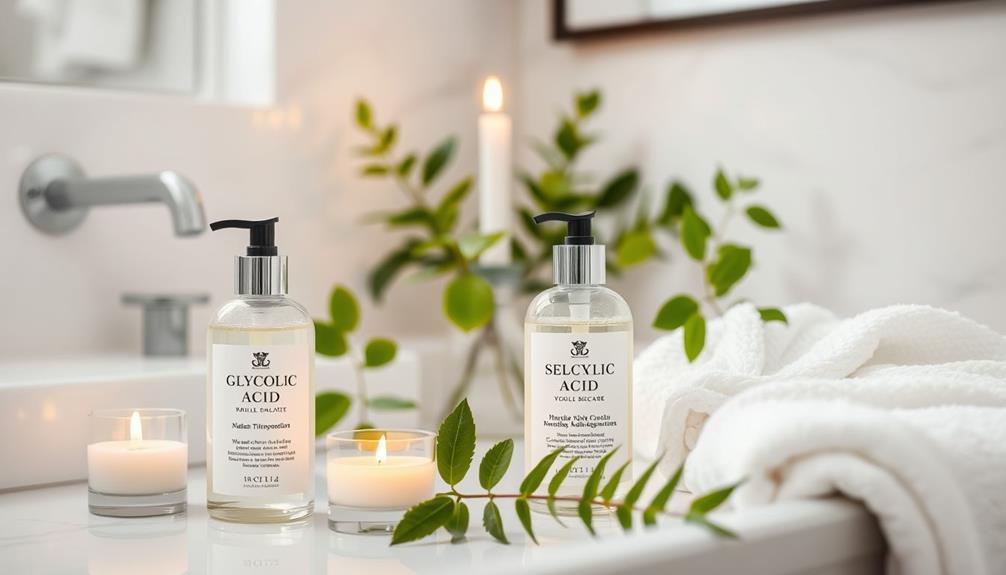
To create a sustainable long-term skincare strategy with glycolic and salicylic acid, you'll want to contemplate your specific skin type and concerns. If you have oily or acne-prone skin, salicylic acid could be a good choice for targeting blemishes and controlling excess oil. On the other hand, glycolic acid is often recommended for improving the overall texture and tone of the skin. The benefits of glycolic acid include exfoliation, increased cell turnover, and improved hydration. By understanding the specific benefits of these ingredients, you can tailor your skincare routine to address your unique needs.
Developing consistent routines and adjusting products based on how your skin reacts will help you achieve the best results.
Sustainable Routine Practices
Establishing a sustainable skincare routine with glycolic and salicylic acids can greatly enhance your long-term skin health. By promoting consistent cell turnover and preventing clogged pores, these acids contribute to clearer skin over time.
Here's how to create a balanced approach:
- Start with low concentrations of glycolic acid and salicylic acid, gradually increasing usage as your skin adapts.
- Alternate their applications on different days to maximize exfoliation while avoiding over-exfoliation.
Long-term use of glycolic acid can stimulate collagen production, improving skin firmness and reducing fine lines. However, monitoring your skin's reactions is essential to prevent irritation.
As you develop this sustainable routine, focus on the health of your skin barrier and adjust the products based on how your skin responds. This thoughtful approach won't only enhance your skin health but also guarantee that you're making the most of the powerful combination of glycolic and salicylic acids.
Skin Type Considerations
When choosing glycolic and salicylic acids for your skincare routine, it's vital to take into account your skin type to achieve the best results over time.
Glycolic acid works wonders for dry skin types, enhancing texture and reducing fine lines. If you have aging skin, incorporating glycolic acid can be particularly beneficial.
On the other hand, if you struggle with oily skin and acne, salicylic acid is your go-to. It penetrates deep into the pores, effectively unclogging them and preventing breakouts.
For those with sensitive skin, it's important to approach the combination of these acids cautiously. Start with lower concentrations of both glycolic and salicylic acids, and keep an eye out for any irritation.
Personalized skincare routines that consider your specific skin type and concerns can maximize the benefits of using both acids. They target different layers of the skin and address various issues, promoting overall skin health.
Regular consultations with a dermatologist can help you determine the most suitable acid combination for your long-term skin care strategy, ensuring you achieve your desired results safely and effectively.
Professional Recommendations
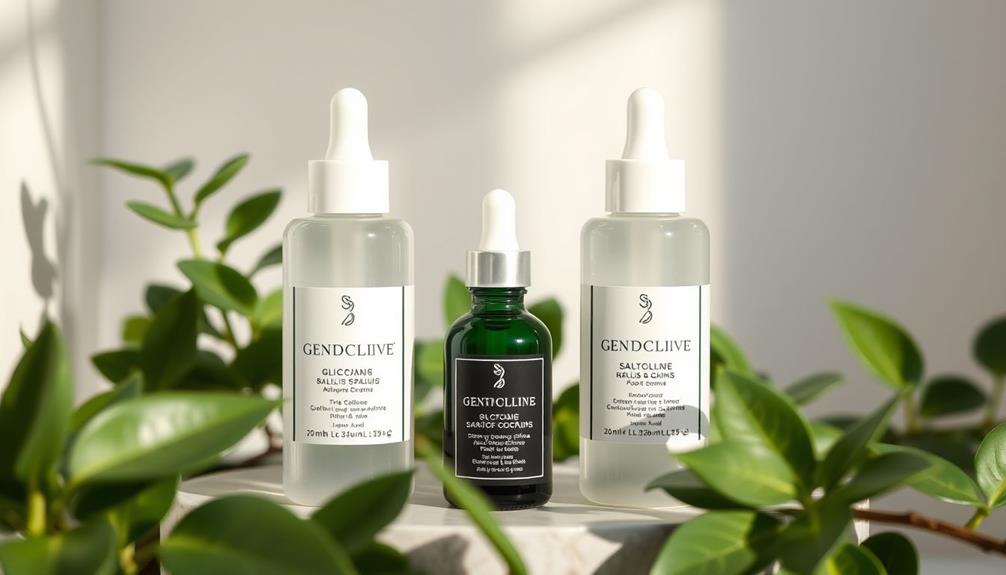
Dermatologists often suggest starting with low concentrations of glycolic and salicylic acids to help ease your skin into the treatment and reduce irritation. This approach allows you to gauge your skin's tolerance without overwhelming it. Before diving in, consider scheduling professional consultations to tailor a regimen that suits your unique skin needs.
Here are some key steps to keep in mind:
- Patch Testing: Always conduct patch testing before using both acids together. This helps assess your skin tolerance and identify any potential reactions.
- Gradual Introduction: Begin with one product at a time, slowly introducing the second. This method lets you monitor how your skin responds.
Understanding Your Skin Type
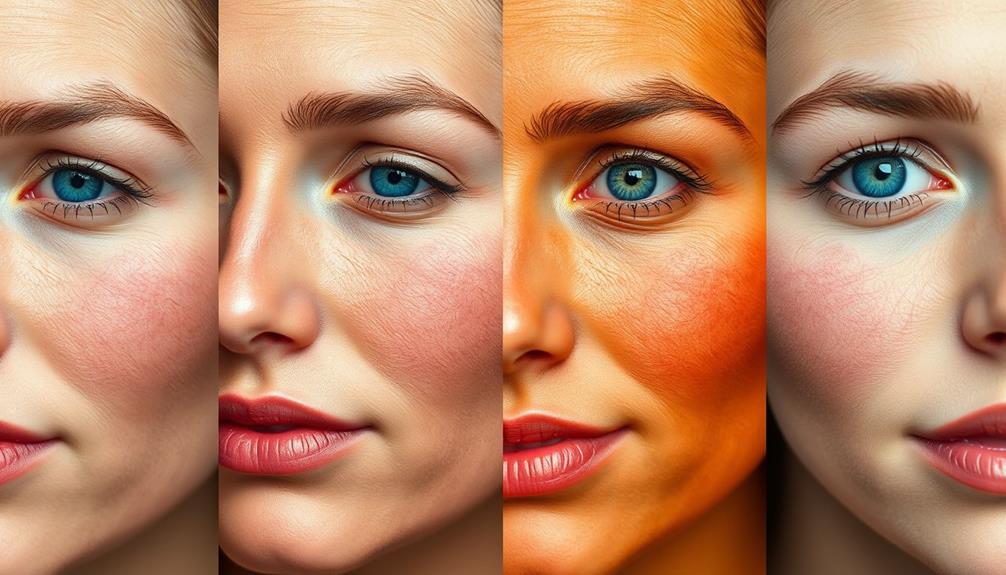
Knowing your skin type is essential for choosing the right products, as each type reacts differently to active ingredients like glycolic and salicylic acids.
If you have oily skin, salicylic acid is typically your best bet, as it penetrates deep into pores to unclog them and reduce breakouts. Glycolic acid can also help by exfoliating the surface and improving texture, but it mightn't be as effective for oil control.
For those with dry skin, glycolic acid is usually more beneficial. It promotes moisture retention and skin renewal without stripping essential oils, making it a great choice for maintaining hydration.
If your skin falls somewhere in between, known as combination skin, you can use both acids strategically—glycolic acid for rough patches and salicylic acid for oilier areas.
Sensitive skin types should proceed with caution. Start with lower concentrations of both acids and consider alternating their use to minimize irritation and avoid adverse reactions.
Understanding your skin type will help you harness the full power of glycolic and salicylic acids effectively.
Frequently Asked Questions
Can You Use Both Glycolic Acid and Salicylic Acid Together?
You can use both glycolic and salicylic acids together, but it's crucial to start with low concentrations and alternate their use. This helps prevent irritation and guarantees your skin adjusts to the treatment effectively.
What Are the Benefits of Glycolic Acid and Salicylic Acid?
Ever noticed how your skin changes with the seasons? Glycolic acid brightens and smooths while salicylic acid clears pores and fights acne. Together, they transform your complexion, targeting fine lines and uneven texture effectively.
Which Is More Powerful Salicylic Acid or Glycolic Acid?
When comparing salicylic acid and glycolic acid, salicylic acid's more powerful for treating active acne due to its deeper penetration and oil-reducing effects, while glycolic acid excels in improving overall skin texture and tone.
Can I Use Salicylic Acid in the Morning and Glycolic Acid at Night?
When it comes to skincare, you've hit the nail on the head! Yes, you can use salicylic acid in the morning and glycolic acid at night for effective acne control and skin renewal.
Conclusion
In the world of skincare, combining glycolic and salicylic acid is like creating a powerful duet, harmonizing to reveal fresh, radiant skin.
As you navigate this dynamic duo, think of it as cultivating a vibrant garden—nurturing your unique skin type while being mindful of reactions.
With careful application and professional guidance, you're setting the stage for a flourishing complexion.
Embrace this journey, and watch your skin bloom into its healthiest self.
